Carrying on the spirit of Noto
・・・・・・・・・・
Hello everyone, how are you all? This is Tanaka from GRIDFRAME.
<Enter the space like opening a book>
The SOTOCHIKU showroom in Omotesando has another feature that we did not introduce in the previous issue.
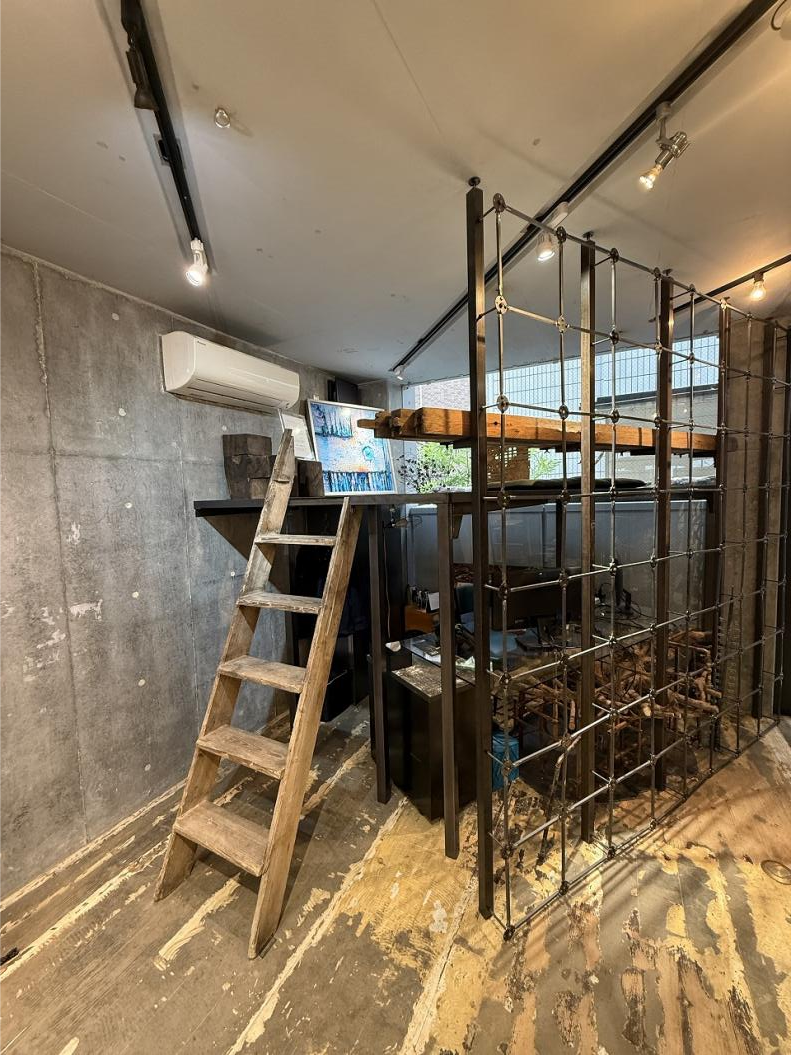
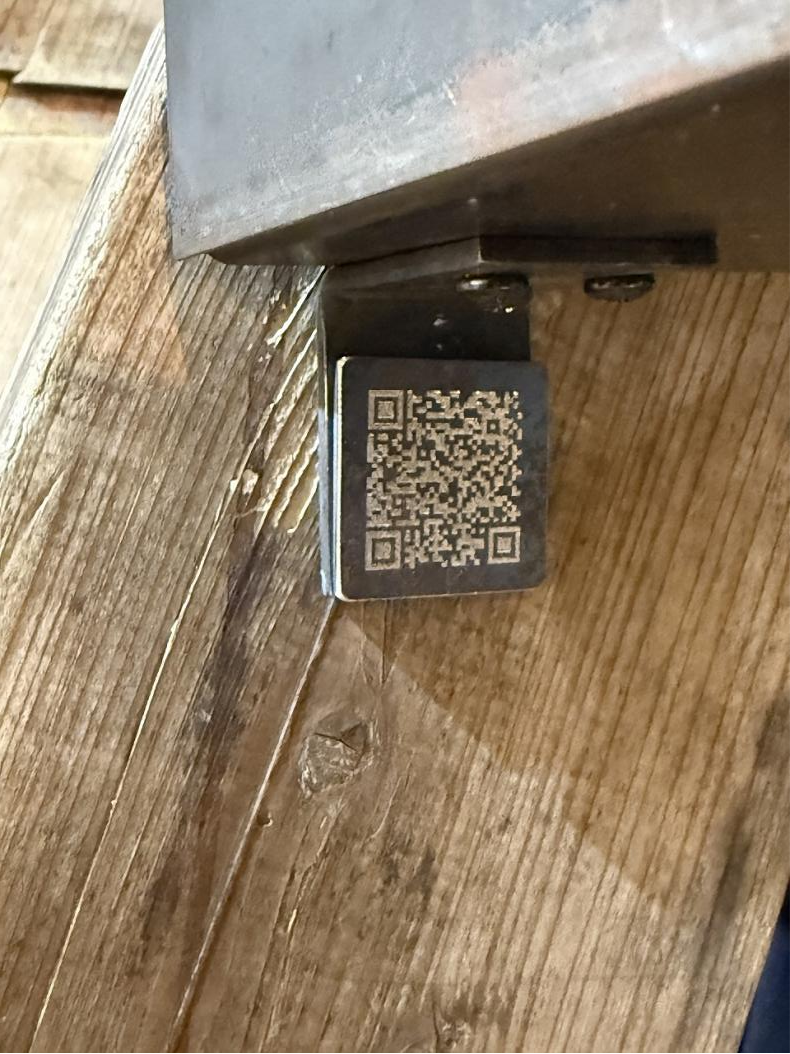
Each SOTOCHIKU material has a QR code attached, which allows you to read the spatial story associated with that material. (The QR code is carved into the iron. You can also read “The Story of the Ladder” in this photo.)
SOTOCHIKU materials always have a story that has been recorded over time. We have created a mechanism that allows you to enjoy the story that shows the relationship between material and space, such as the inspiration that the material gave to creating the space, just like reading a book, by expressing that story based on interviews with people who have spent time with the material.
From now on, we would like to include a story in each space we create, making it feel like you’ve entered a book.
<Inheriting the spirit of Noto>
I visited Noto for the first time in about six months to collect SOTOCHIKU materials. When the materials are used in the space, they are converted into cash, 60% of which is donated to the NPO. (40% will be used as a processing fee for GRIDFRAME.) The NPO will send a donation certificate to donors around the end of January, and by submitting this when filing their tax return, they can receive a donation deduction.

This will be Tanaka’s sixth visit to Noto since the earthquake. GF staff member M, who visited Noto 11 times last year, will be leaving GF for the time being this year.
This year, we have reached a stage where we must shift our activities from last year’s disaster volunteer-centered activities to creating spaces that only GRIDFRAME can provide.
During my recent visit to Noto, I got the impression that the roads in the frequently visited places have been cleaned up and that demolition has progressed considerably. In other words, the broken things are gradually disappearing.
Many people will be happy to see all the broken things removed, but as I have emphasized in previous communications, this is not my ideal. I believe that leaving even a small amount of the broken things and combining them with new things will definitely create an attractive, unique space and revitalize Noto.
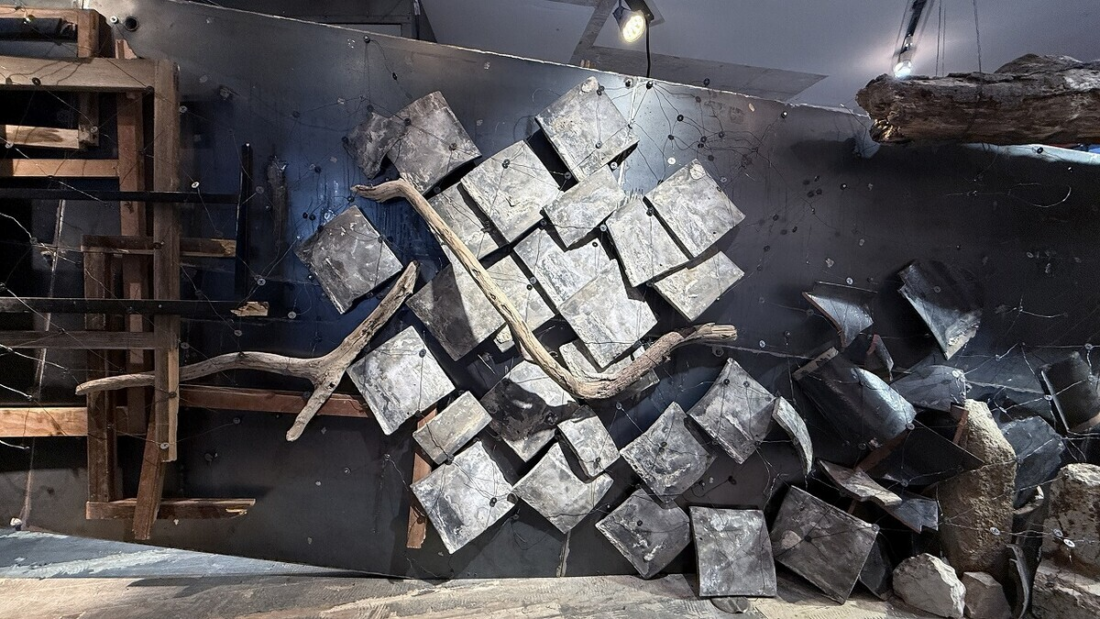
We believe that by creating spaces in Noto, such as shops and inns with creative objects that carry on the time of the earthquake, as proposed in vol. 11 and vol. 14, we can pass on the spirit that has been passed down to the next generation.
To create a space filled with stories for the future, we absolutely need the things that were damaged in the earthquake. As with the initiative mentioned at the beginning, we would like to carefully create a space where we can attach QR codes to damaged objects and read the stories related to the materials.
Local governments are moving quickly towards their goal of completing the publicly funded demolition by October of this year, but some roads to marginal villages have been left in a damaged state, and it seems unlikely that all of the damaged items will be lost.
We would like to start looking into whether we can receive any offers for the space. If you are interested, please contact us at info@gridframe.co.jp.
So, if I get an offer, I think I might be able to create another opportunity to visit Noto with Mr. M. This time, I traveled with new staff member Mr. Suzawa for the first time, pulling the SOTOCHIKU trailer.
<Collecting SOTOCHIKU materials and interviews>
The buildings scheduled for demolition in Noto this time to collect SOTOCHIKU materials are one house in Ukawa, Noto Town, and three houses in Kaminoyama and Kitayama, Wakayama Town, Suzu City.
[At Ukawa, Noto Town]
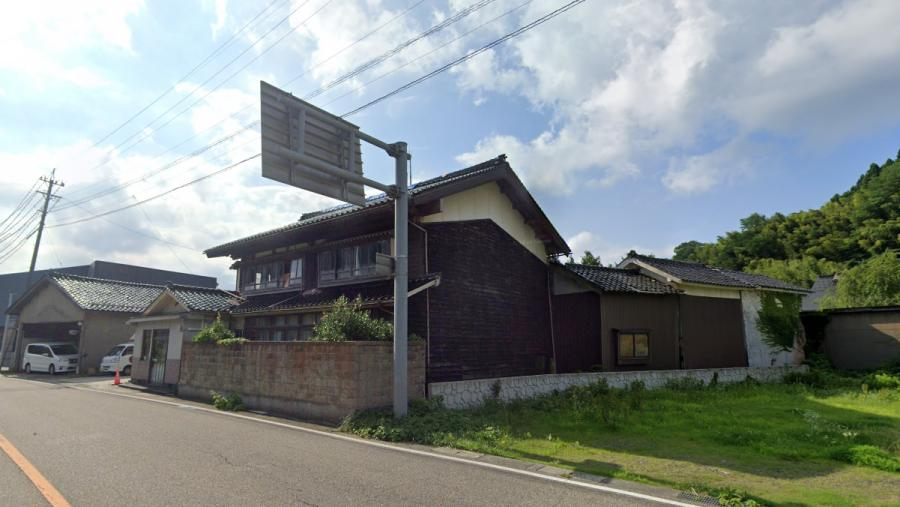

As in August last year, we were helped by Mr. O from Udezu, and at our first house, Mr. TR from Ukawa, a coastal town in Noto Town, he donated the floorboards under the tatami mats and we were able to talk to him.
・・・・・・・・・
-When was it built?
“This house was built by my grandfather 65 years ago when our family moved from the riverside. Our family has been in the construction business for generations. I was two years old when it was built and grew up here. The older folk lived on the first floor and the younger folk lived on the second floor, and we would gather in the tatami room and have a great time drinking.”
“We grew up here, raised our children here, and now our children can return to it after they have left home. Our big house gradually became too big. Now, my husband and I only use the kitchen and dining table.”
“Our three children were supposed to come home for New Year’s, but by chance none of them came home, so everyone was safe. My husband and I had to hold down the cupboards to stop them from falling over.”
-How do you feel about the house you’ve lived in since you were a child being demolished?
“I can’t bear to tear down the house that has been passed down from my grandfather’s generation. This feeling is the strongest. And I’m tearing down a building that is a testament to my life. So I’m going to keep as many commemorative items as possible. For example, the hearth, the iron kettle, etc. I’ve asked my children if they want any memorable items, but they said no, lol.”
-What do you think about parts of demolished houses being donated as SOTOCHIKU materials and used to create spaces around Tokyo?
“It would be fine if it was somewhere nearby like Kanazawa, but I don’t think most people can go to see it in Tokyo. There may be some people who want to see it once before they die, but I love traveling, so I will go see it someday, so please let me know if you use it.”
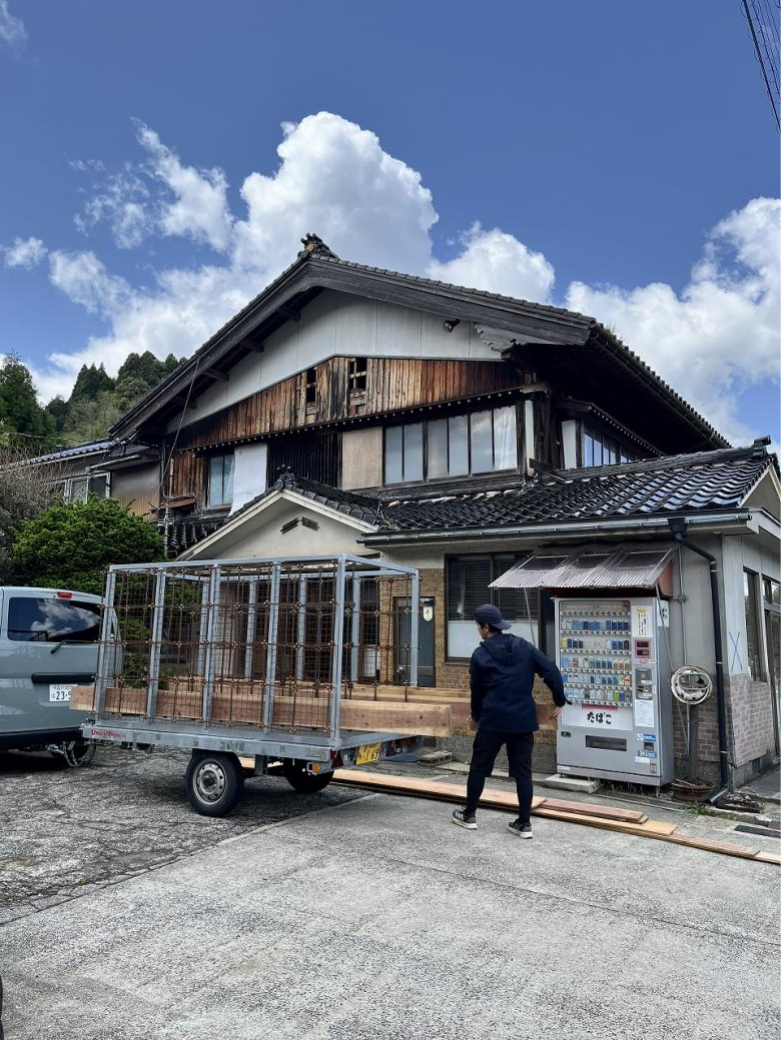
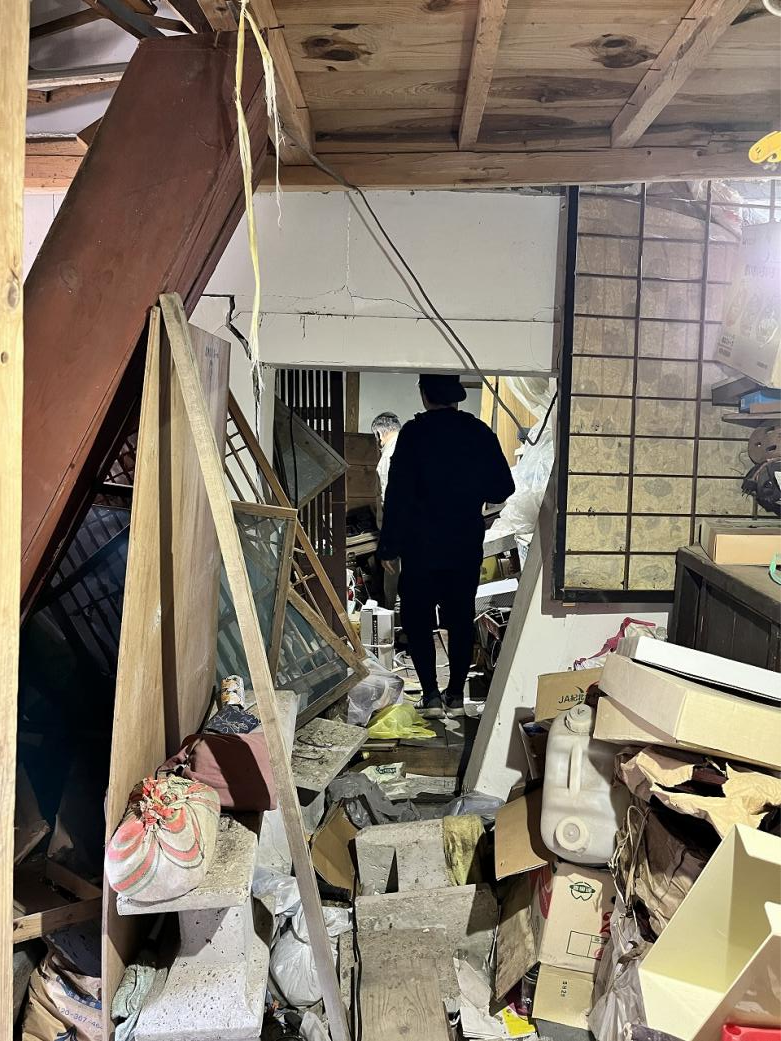
-What was it like immediately after the earthquake?
“Although some houses were destroyed in this area, no one was killed. Apparently, one of the young men went around to the destroyed houses, calling out to people, and managed to pull out four people and save them. He thought that he had done well in his own difficult time.”
“The earthquake was scary, but what was even scarier was the aftermath, when there would be no food and no toilet facilities. I never want to go through that again. At the evacuation center, people’s selfish behavior was often revealed. When we were waiting in line to receive our food rations, some people would complain, ‘I’m the only one who’s so small.'”
-How is your life currently?
“I’m in temporary housing and I’m a group leader. There are six of us group leaders, and we have fun discussing and resolving various problems and planning events. But the children live quietly, and some elderly people don’t come out. I want them to get out more, play freely, and chat.”
“There are many elderly people living alone. There was one case where someone didn’t come out and turned out to have passed away. They said they heard a loud thud.”
“But because we’re in temporary housing, we can still hear the thumping sounds. If we were back in a house, we wouldn’t be able to hear them. So we want to make sure that no one dies alone.”
“A woman from Mashiki Town who experienced the Kumamoto earthquake came to stay at our temporary housing. We were each paying our own electricity bills, but she explained her experience living in temporary housing in Kumamoto to the town office, which relieved us of that burden, and we were very grateful.”
-What does the reconstruction of Noto mean?
“The people who left are not coming back, so even if things return to normal, life will not return to normal.”
“When I visited the areas affected by the Great East Japan Earthquake, I was stunned to see the seawalls over 10 meters high erected on the coast. I also visited Kumamoto about a year later, and I remember that there were still many blue tarps. I think we should listen more to the people of eastern Japan and Kumamoto and think about the future.”
“What is clear is the issue of roads. Apparently there were 11 in Kobe. Noto only had one. Roads were important. I will never forget the hell of not having food or toilets.”
・・・・・・・・・
This time, we were able to sample floorboards from two 8-tatami rooms. One room had relatively new 12-foot wooden boards, while the other had 6-foot lacquered wooden boards that were probably 65 years old. Both were excellent boards.
In fact, the most impressive material we found this time was one that we couldn’t collect and take home. It was found in the damaged exterior wall on the second floor.
I felt as if a god was dwelling there, as I stood there for a while, watching the outside light flood in on the other side of the broken earthen wall, with half of the Takeshimai soil still remaining. Although I cannot preserve this crumbling state and harvest the material at any moment, I would like to make sure to use this valuable experience in creating spaces in the future.
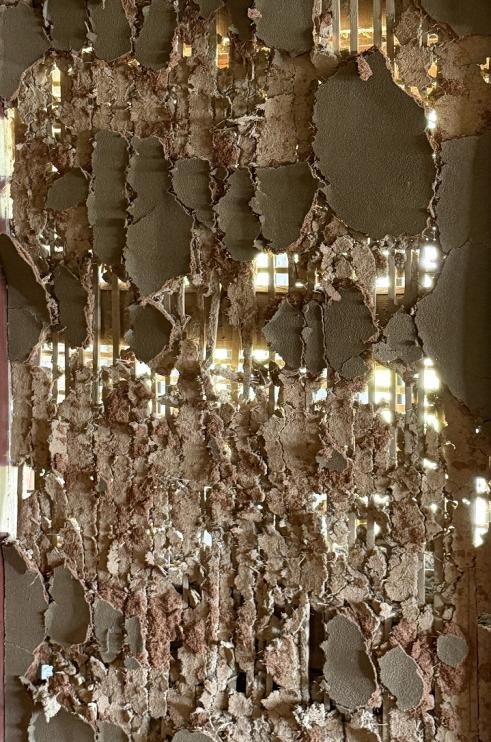
[At Kaminoyama, Wakayama-cho, Suzu City]
With the help of artists NH and UY, who continue to volunteer here, they introduced us to several properties in Kitayama and Kaminoyama, Wakayama Town, Suzu City, where we were able to collect samples.
In the morning, while I was getting ready at my lodging in Kaminoyama village, a local resident named NS came over and showed me around the area. First, we went to the house next to the lodging, which is scheduled to be demolished soon.
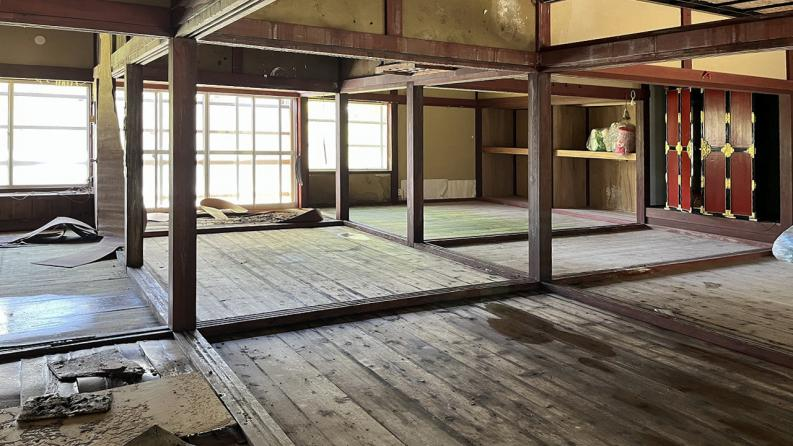
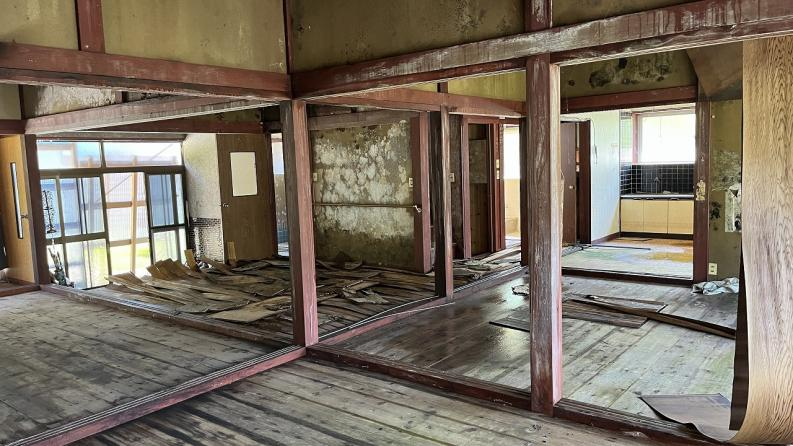
When I went inside, I was surprised to see that the pillars were not leaning at all. They were all standing straight. Even the house my mother still lives in, which was partially destroyed in the Kumamoto earthquake, had pillars that were leaning slightly. And yet this house was going to be demolished.
The cause was rain. The house had been left abandoned for 16 months after the earthquake, and continued to leak, causing mold to grow and the wood to rot, making it uninhabitable.
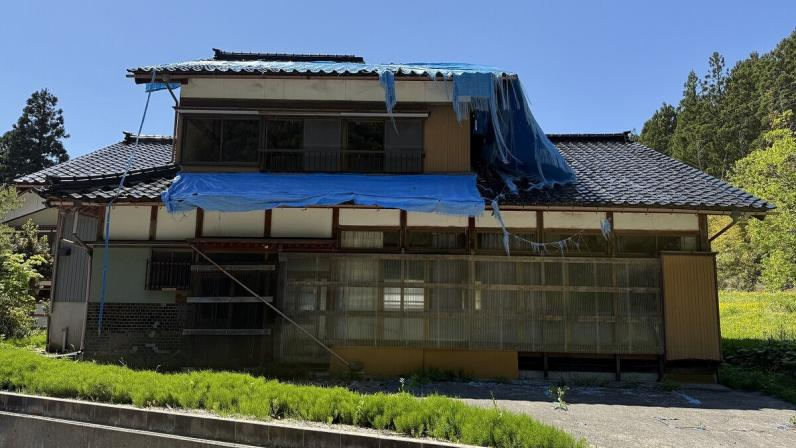

I went outside and looked at the roof, starting from the road side.
At the back of the house, half the top of the gable roof has tumbled to the ground.
Looking at the fallen structure, we can see that the top of the roof was cemented in place with mortar. According to NS, in the past, roofs were cemented with a mixture of earth and straw, like mud walls, which allowed them to absorb earthquake tremors, but recently, because they have been replaced with mortar, they have become very hard and have become completely destroyed by the shaking, causing the entire structure to roll down.
The impact of the fall also caused the tiles on the slope to break. In other words, the only damage to this house was the collapse of the top of the roof.
NS’s house was built using earth, so the top remained intact and it was easy to repair, which is why he is still able to live in it.
At this house, we were able to collect part of the fallen roof peak, which was the only reason the house was being demolished.
NS says they should have focused on fixing the roof first.
“The city of Suzu has been trying to expedite the demolition. If the roofs had been repaired, I don’t think so many traditional Noto houses would have been lost.”
“Also, one of the conditions for publicly funded demolition was that all belongings had to be removed, so valuable lacquerware and furniture were thrown away. Now, that condition has been abolished, and publicly funded demolition is accepted even if all belongings remain.”
Come to think of it, most of the early volunteer work that GF staff member M participated in involved moving out household belongings.
NS hopes that as many traditional houses as possible will remain in this area. NH and many others are also working hard, lobbying local government and landlords to find ways to stop the demolition. I believe that the fact that the demolition was postponed even after applying for public funding for the demolition is a result of their efforts.
On the other hand, there is currently a rush of demolition going on. From what I could see, there were more than 10 demolitions underway in various places.
[In Kitayama, Wakayama-cho, Suzu City]
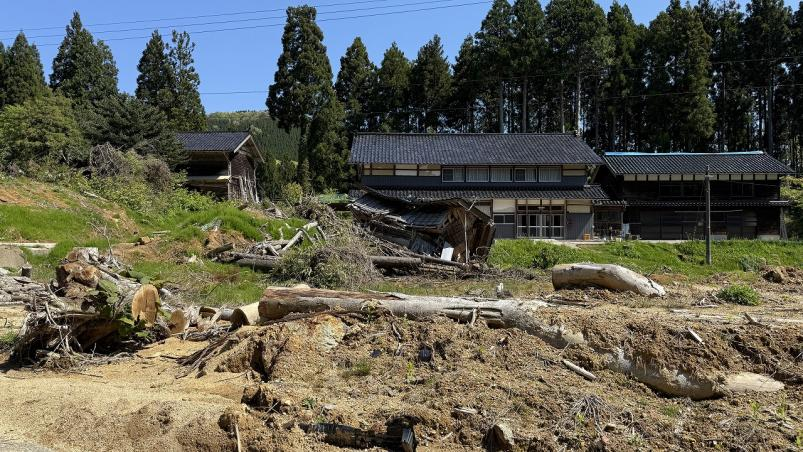
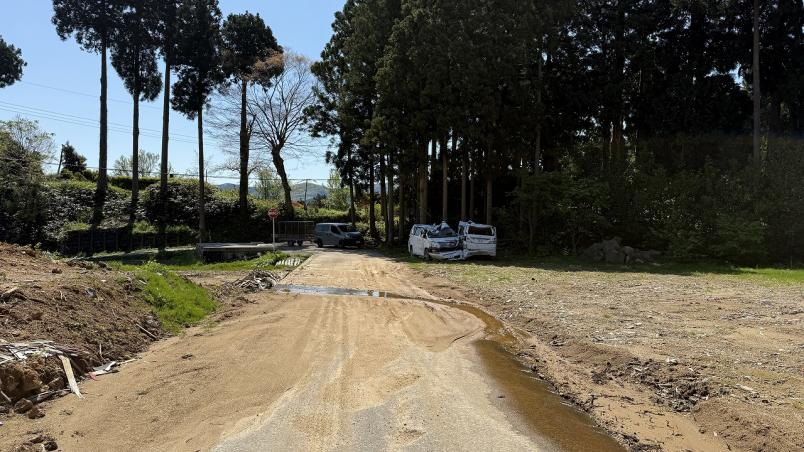
Once we entered Kitayama village, the SoftBank phone no longer had signal. My companion, Mr. Suzawa, had a personal Docomo phone, so we were just barely able to get through. In Kaminoyama, the SoftBank phone had better signal.

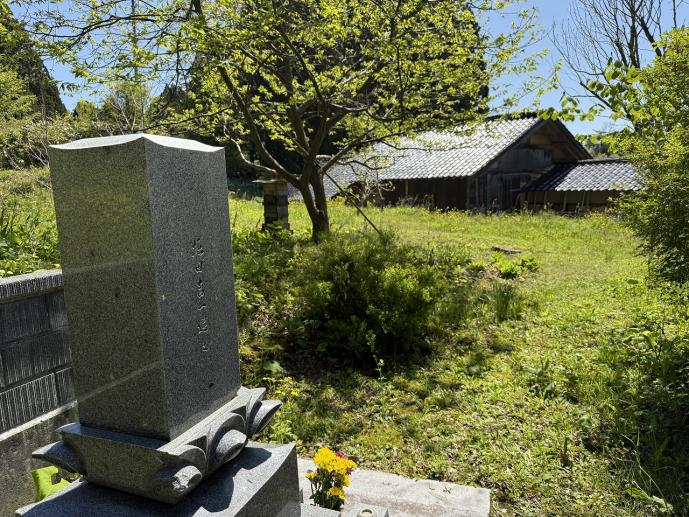
Mr. HM’s house is at the end of a mountain path that branches off from the main road and continues for several hundred meters. It was built about 80 years ago and his father has been repairing it himself.
We were able to collect some corrugated iron sheets from the exterior walls of this house. The older brother of the owner said that the sheets were installed when he was a child.
Apparently the site is scheduled to be vacant by the end of May, but they haven’t thought about what will happen after that yet.
In Kitayama village, it seems that many homes have graves on their property, and this house also has one, so people will be able to come and visit the grave in the future.
The roads around TN’s house were barely repaired, making it difficult for trailers to pass through.

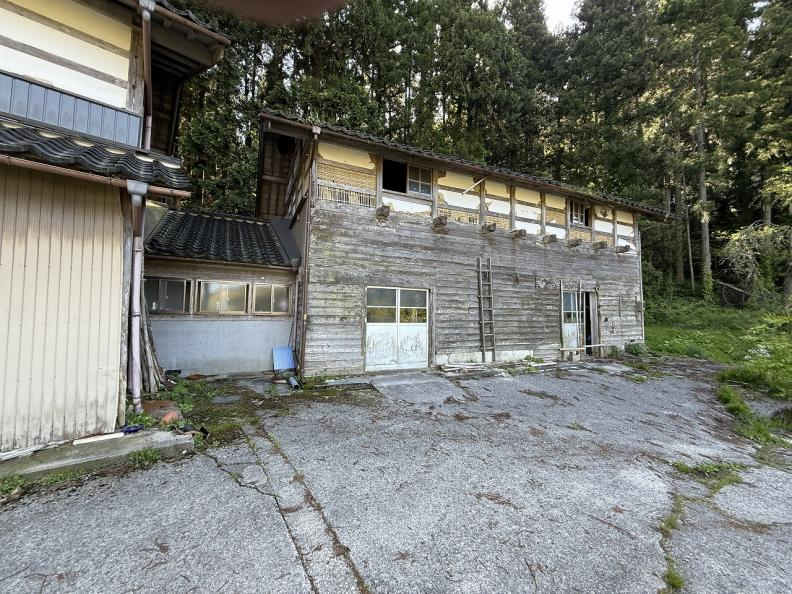
The building is about 100 years old and has undergone repeated renovations. As it is located on a hill, it offers a great view of the fields below, and it must have been a very pleasant place before the earthquake.
The second floor is used as a bedroom, and also as TN’s calligraphy room. “My handwriting was messy, so I practiced here,” he modestly says, but the room is filled with beautifully written calligraphy on paper.
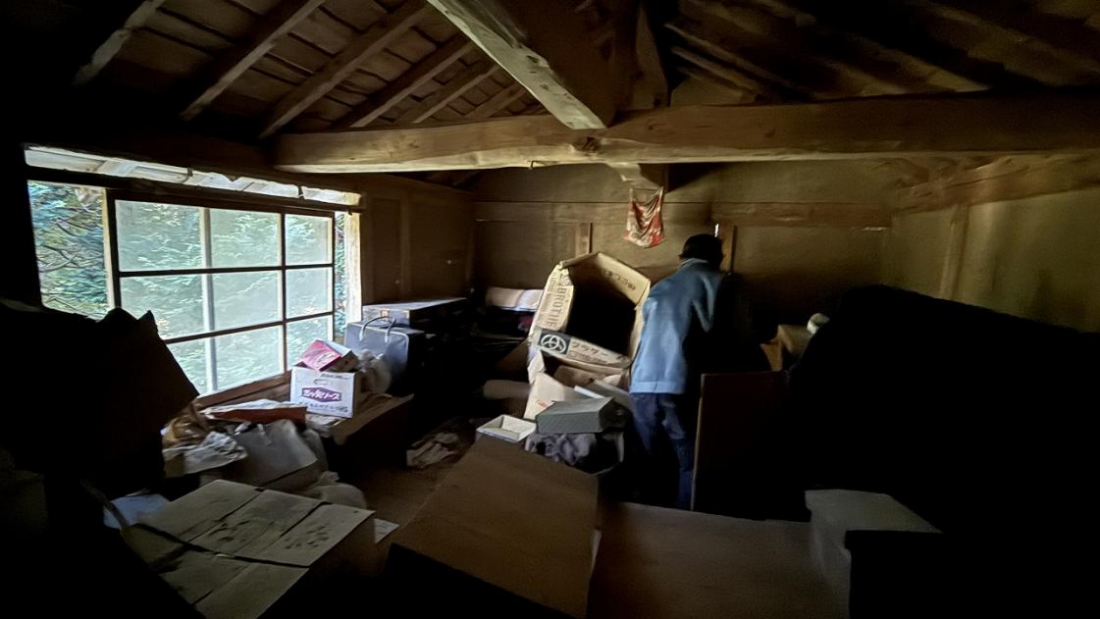
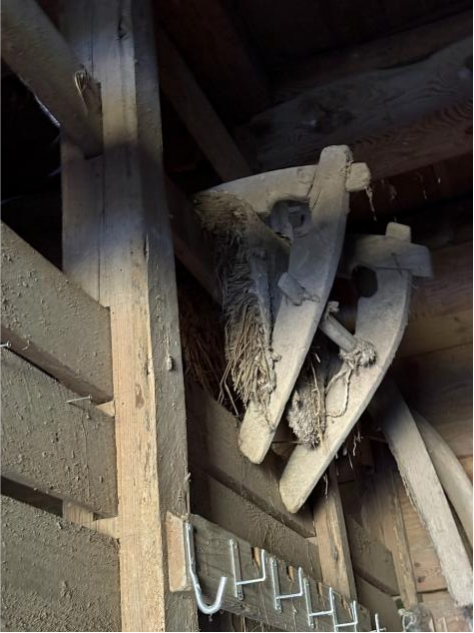
There were various boxes stored in the dimly lit barn. TN opened each box one by one and found something that looked like a family memo pad, which he gazed upon in fascination. We also received donations of a kimono sash and a wicker basket for clothing.
Furthermore, at another barn, we received a donation of a load carrying device that is used to carry things on the backs of cows. The owner said that he had never seen anyone use it before. It must have been used over 80 years ago.
“It really is a big and impressive house,” I said, and he said, “But look,” pointing to a cedar tree that had fallen from behind the house and was now hanging over the roof.
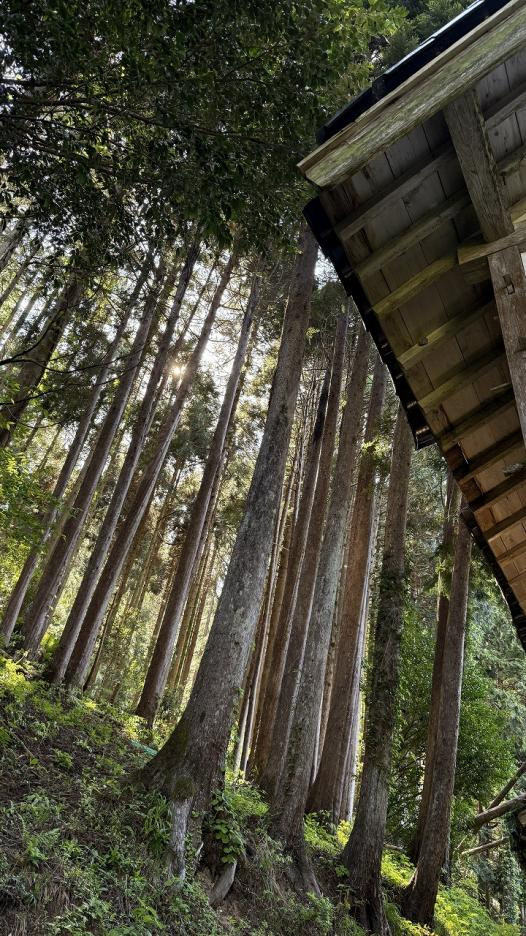
Apparently the damage in this area was worse from the heavy rains in September than from the earthquake in January, and a large landslide occurred on the nearby mountain behind the house. Behind the house, several cedar trees had fallen and were now hanging over the roof. It is unclear whether more trees will fall one by one or all at once.
Is this what Kunio Yanagida meant by the hidden mountain?
After death, spirits ascend to the small hills or forests behind the house. It is said that it was believed that they first ascend to the mountains as wild spirits, gradually become ancestral spirits, and eventually rise to the status of gods.
This house also has an ancestral grave on its grounds, and one cannot help but feel the strong connection to their ancestors. Perhaps TN decided to demolish the house because the mountain behind it was collapsing. With this thought in mind, I looked up at the light shining through the cedar trees.
Seeing distant things up close
As I looked up at the light, I thought about the wonder of how people can think about faraway things that exist within themselves, and how they live their lives believing that such things exist somewhere.
The distant things can literally be something far away, something we revere, something precious that has been lost, or something we cannot understand – they vary depending on the person and the time. I feel that we all have something like that that moves us, even though we cannot usually see it.
At some point, you suddenly feel as if you’ve seen something far away, and it takes your breath away. That’s the kind of thing that happens when something is far away.
During my visit to Noto this time, while listening to the owners’ stories and watching the houses being demolished, I witnessed many moments when the owners narrowed their eyes and gazed upon something. Each time, I felt a sense of calm, as if I had suddenly encountered something far away that was deep within me.

I believe that SOTOCHIKU materials, which have stored memories of a long time, have the power to convey the feelings of others who have spent time with them to one’s own heart. This power of communication is further strengthened by reading the stories of the materials connected by QR codes attached to the SOTOCHIKU materials in the created space, allowing visitors to experience the space as if reading a book.

I would like to make sure that the QR code is placed in an inconspicuous location that blends in with the artwork and does not interfere with the atmosphere of the space, rather than in a place that is easily visible to everyone.
If you are planning to experience the SOTOCHIKU space in the future, please find the QR code. We hope that you will spend your time gazing into the distance with gentle eyes.
<Spaces created by GRIDFRAME>
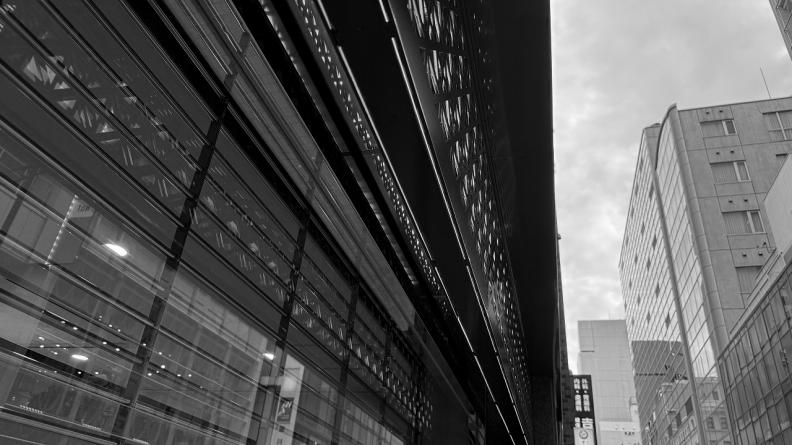
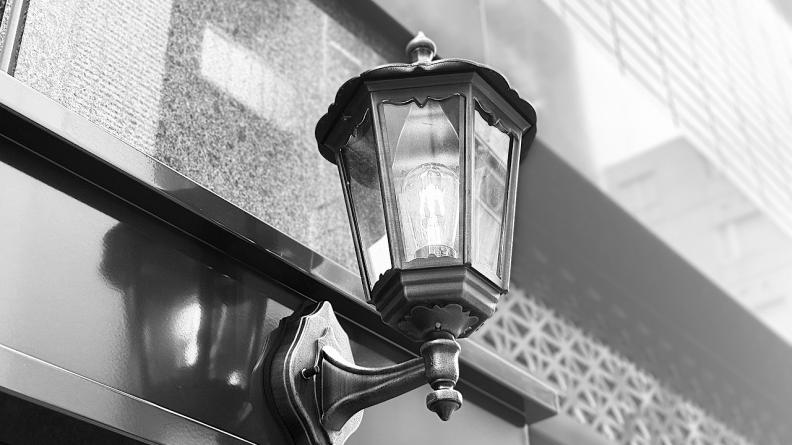
In May, we created a gallery space in Ginza. Although we did not use any SOTOHIKU materials, the space made use of our material-making and production capabilities in the factory.
If you are interested in a space that makes use of SOTOCHIKU materials, a space that makes use of painted miracle steel plates, a space that makes use of GRIDFRAME’s production capabilities, or a space where you “enter the space like opening a book,” please
contact us at info@gridframe.co.jp.
In the next issue, we would like to continue to tell you about SOTOCHIKU’s various activities.
May 31, 2025 GRIDFRAME Toshiro Tanaka

Comments are closed